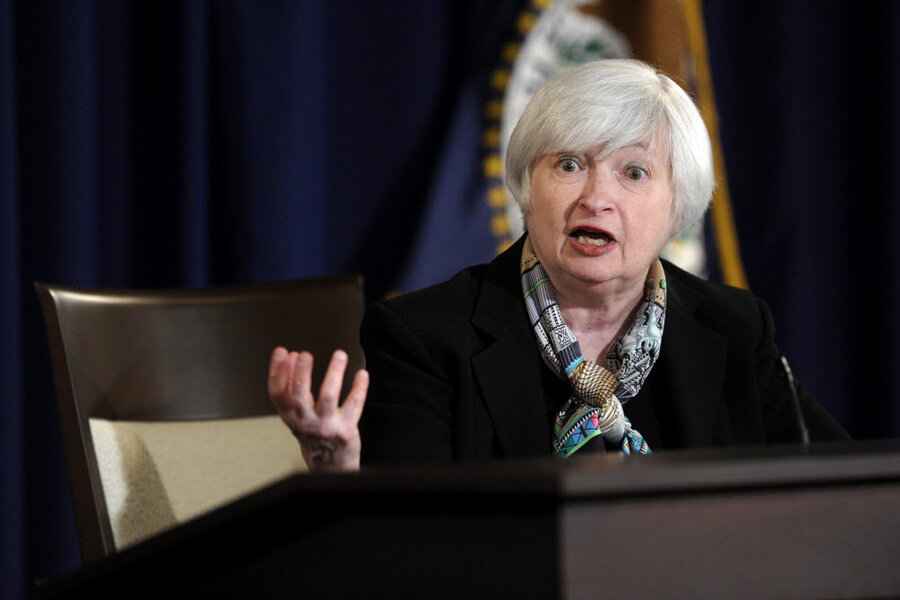Janet Yellen ponders when to raise rates, but Fed guidance vague
Loading...
| Washington
The Federal Reserve gave new guidance to the public on interest rates Wednesday, confirming that the calendar will probably tick into 2015 before Fed policymakers vote for a rate hike.
But the central bank’s newly released “forward guidance” is also vague. It gives investors few precise insights into which metrics would play a decisive role in triggering the rate increase.
Fed Chair Janet Yellen emphasized this, however: The Fed expects that, even once it starts moving to raise short-term interest rates, the upward path of rate hikes will probably be slow.
Speaking at her first press conference as chair, Ms. Yellen said the Fed’s policy committee expects the economy to need some extra support from the Fed – in the form of lower-than-normal interest rates – even once America is back near full employment.
“We have had a series of years now in which growth has proven disappointing,” she said, adding that committee members see various challenges that could continue to weigh on the economy’s performance. Those factors include the many households where mortgage debt still exceeds home value and the federal government’s adopting of less-stimulative fiscal policies.
The Fed's policy statement Wednesday said a move to hike rates will probably come a "considerable time" after the end of another effort to revive the economy, the Fed's program of monthly bond purchases. The bond-buying could be phased out by late this year, and Yellen said that the "considerable time" after that might mean something on the order of six months.
Forecasts by Fed officials suggest that the central bank’s short-term lending rate will rise to about 1 percent by the end of 2015 and perhaps 2.25 percent by 2016.
That consensus forecast has edged up since the last time Fed predictions were released in December – and the news prompted a dip in stock prices as the yield on 10-year US Treasury bonds edged up to 2.77 percent.
Still, Yellen noted that this outlook for 2016 is consistent with the Fed’s new guidance. Policymakers expect the economy to be at or near full employment by then, yet they’re projecting a short-term interest rate then that would be well below what the Fed sees as a long-run norm of 4 percent or so.
The Fed’s aim Wednesday was to provide some new information – and perhaps comfort from any fear of rapid rate increases – to financial markets at a time when the Fed’s old guidance was being rendered obsolete. For more than a year, the Fed had talked about 6.5 percent unemployment as a threshold, above which any rate hike wouldn’t happen (unless inflation showed an unsettling resurgence). Now, with the jobless rate approaching that level, new guidance was needed.
The policy committee chose not to include any new threshold number to replace 6.5 percent unemployment. The new guidance says the policymakers will weigh “a wide range of information” on inflation, the job market, and private-sector financial conditions.
Although vague, the Fed committee’s joint statement serves as a reminder: Interest rate policy could start shifting away from current near-zero levels in as little as a year. As that day appears to draw closer, it could have sizable import for consumers and businesses around the world – since expectations about Fed policy can influence private-sector interest rates.
What economic data will Yellen and her colleagues be watching most closely as they consider the timing and speed of rate hikes?
Some are obvious: The Fed will want to see solid growth in the economy, and an unemployment rate that’s falling steadily back toward the level typical of non-recession times – which the policymakers peg at about 5.2 to 5.6 percent.
Yellen also repeated the Fed’s current view that inflation should be running at about a 2 percent annual rate – not much hotter or colder than that. The Fed will also be watching for any worrisome signs of bubbles in the prices of stocks or homes – which could be signs of too much monetary stimulus by the Fed.
At the press conference, Yellen also commented in some detail about how Fed officials are looking not just at the official unemployment rate, but also at a range of other labor indicators, to gauge when the economy will be approaching full employment.
Yellen said the following are on her dashboard:
• The share of jobless people who are “long-term unemployed” (for more than half a year). She called the level high and “stubborn,” still above one-third of the unemployed.
• The number of workers who have part-time jobs but want full time ones.
• The rate of participation by adults in the labor force. She said it’s generally declining due to a wave of baby boomers retiring, but that an improving economy should also draw at least some people from the sidelines back into the job hunt. “That’s something I’m watching closely,” she said.
• “Quit rate” figures, which show how many people are opting to leave a job and look for another. Because this shows a level of confidence in being able to find new jobs, Yellen said it’s a useful sign of the economy’s health.
• Wages. She said in a strong economy workers should be enjoying wage gains above inflation.
The dial on most of these gauges shows improvement, Yellen said, but more progress is needed.






